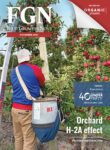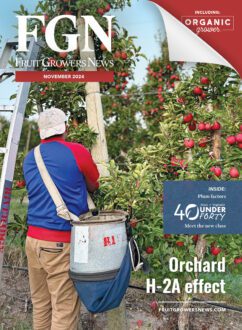Apr 7, 2007Next Big Thing Is New Co-op for Marketing MN1914 Apple
After Pepin Heights Orchards was awarded the exclusive rights to market MN1914, the University of Minnesota’s new apple, everyone knew something else was going to happen. In July, it did.
It’s called the Next Big Thing. NBT is a 45-member cooperative of growers, spread over five time zones from Nova Scotia to Washington state, that will grow and market MN1914 as a yet-unnamed premium apple. Dennis Courtier, the owner and chief executive officer of Pepin Heights, is chairman of the new co-op, which will be headquartered with Pepin Heights in Lake City, Minn.
The president of NBT is Tim Byrne, Pepin Heights’ vice president of sales and marketing.
The members will begin planting the trees next spring, when about 45,000 will go into the ground, according to Courtier, and “the remainder” will be planted in 2008 and 2009. By 2011 or 2012, the marketing component of the plan will go into action, taking these new apples through five regional packinghouses and to market as one national brand.
The cooperative plans to “ramp up” to annually market boxes counted “in the mid-six-figures” and go on to market other new varieties using the same model, he said. As time goes by, new decisions will be made about how many trees will be planted and how many apples of the new variety will come to market.
The overall strategy of the new co-op is to develop and market new products and is dedicated “to finding great new apple varieties, no matter where they are,” Courtier said. “We want to be the first place anybody with a new apple variety calls. We want to create a system that can introduce new varieties as national brands.”
While Courtier travels the world looking for special apple varieties, Pepin Heights Orchards has had unusually good fortune with varieties developed in its own back yard, not the least of which is Honeycrisp.
The apple breeders at the University of Minnesota (U-M), using the established land-grant university formula of solving local problems for local people, have done well by the apple producers of their state.
A look at the list of apples for sale on the Pepin Heights Orchards Web site (www.pepinheights.com) reveals a list similar to the list of apple varieties U-M breeders have developed since the release of its first variety, Wealthy, more than a century ago. The development of this chance seedling was followed by deliberate breeding efforts that resulted in the release of Minnehaha in 1920 and Haralson in 1923. The list of U-M varieties now includes Zestar and Honeycrisp, as well as Regent, Keepsake, Fireside, Sweet Sixteen and Honeygold.
Honeycrisp has done well for Minnesota growers and for U-M. Since its release in 1991, Minnesota growers have planted thousands of the trees, and each tree produces an estimated $1,000 worth of fruit in its lifetime. That’s according to a document posted in April on U-M’s Web site, which explains in some detail why U-M is not totally satisfied with the path its Honeycrisp is on and why it wanted a more managed arrangement for some of its new introductions.
U-M has one of only four public apple breeding programs in the United States, and it’s located in a state ranking 25th in apple production. About 200 Minnesota growers have about 400,000 trees on 2,500 acres and produce about 600,000 bushels of apples a year.
Yet U-M invests about $400,000 a year in apple breeding, more than half of that funded by royalties from university intellectual property, primarily Honeycrisp. That one variety has produced $3.7 million in royalty income to the university since its release in 1991.
But in 1999, the university’s board of regents created new guidelines to “ensure the results of university research have the maximum possible benefit for Minnesotans and the larger public” and “to realize a fair financial return to the university.”
U-M now combines free public release (like the new apple SnowSweet this year) and licensed rights for MN1914, which it expects will be a premium variety.
Some of the “problems” that brought this arrangement about, according to the document, include:
• The popularity of Honeycrisp has been good for U-M, but it took too long. Bred in 1961 and released in 1991, its patent will expire already in 2008 and royalties will cease “at the same time that demand for the variety is accelerating.”
•
• The discovery of a redder sport of Honeycrisp by a nursery – and rules that allowed it to be patented and marketed as a rival – undercut university royalties.
•
• Quality control has been a problem. Because anyone can plant and market the variety, which has a host of physiological problems in the orchard and in storage, low quality Honeycrisp apples are eroding the quality of the brand.
•
In choosing to partner with Pepin Heights, “the university believes exclusive licensing of MN1914 will serve the interests of the consumer, Minnesota apple growers and the university’s breeding program. Hopefully, the potential for earlier royalty payments and management of MN1914 sports will result in funding to continue the breeding program’s development of apple varieties for Minnesota’s unique growing conditions.”
Not only will NBT growers pay royalties on the trees, they will return to U-M a portion of the fruit sales.
To protect the interests of other Minnesota growers, U-M and Pepin Heights built a licensing agreement that allows them to plant from 100 to 1,000 trees to grow apples to sell in their own retail outlets: farm markets and farmers’ markets.
For Courtier, the overall plan calls for marketing appealing apples with unusual qualities and tastes to people who love good food and seek it out at retail establishments that cater to their needs.
“It’s not about selling apples,” Courtier said. “It’s about gaining a share of someone’s stomach. Consumers must freely choose your product over others they might buy. You must provide consistent quality. You can’t just do quality when it’s convenient. Managing the quality is key.”
Courtier believes the way to sell more apples is to sell better apples.
“People will eat more apples if they really like them,” he said. “You can affect per capita consumption if you put out a product that’s good enough. Great apple varieties are synergistic. They drive total consumption. Great varieties bring people back to the category.”
To be successful, Courtier said, a marketing company has to try to make its own products obsolete – before rivals do it. That means constantly looking for better products.
Controlling sports is also important. The current rules are “really stupid,” he said. A sport should be considered an improved version of an original variety, not a new variety. The search for sports, by growers and nurseries, has undermined the work of breeders and often resulted in cosmetic “improvements” that do not improve – and may even worsen – the variety.
Under the agreement, the licensing partners will control all the budwood of MN1914, including its mutations.
Editor’s note:
For many years, the story of Honeycrisp’s heritage recorded it as the result of a cross between the apple varieties Honeygold and Macoun. But “paternity testing” two years ago revealed that not only wasn’t the father correctly identified, neither was the mom.
DNA testing revealed that one true parent is Keepsake, and the other is not known.
David Bedford, the head of the apple breeding program at University of Minnesota, said, “It might be a numbered selection and even discarded by now.”














